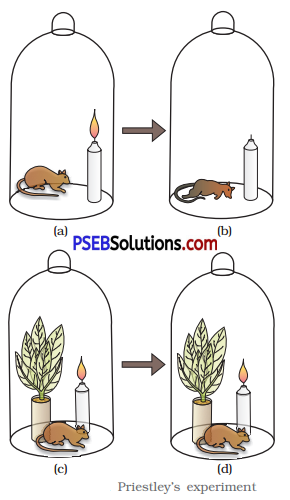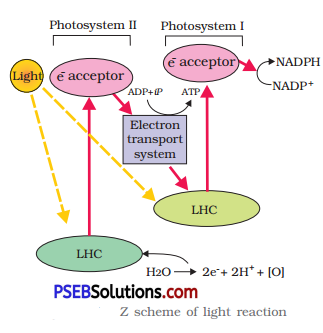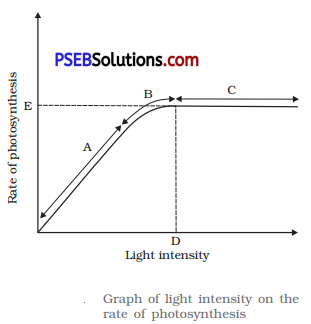Punjab State Board PSEB 11th Class Biology Important Questions Chapter 13 Photosynthesis in Higher Plants Important Questions and Answers.
PSEB 11th Class Biology Important Questions Chapter 13 Photosynthesis in Higher Plants
Very short answer type questions
Question 1.
Photosynthetic pigments are located in which part of the chloroplast? ‘
Answer:
Photosynthetic pigments are located in the lipid part of thylakoid membrane.
Question 2.
Does moonlight support photosynthesis? Find out. [NCERT Exemplar]
Answer:
No, because the intensity of moonlight is several thousand times less than that of direct sunlight, insufficient for the light-dependent phase of photosynthesis.
Question 3.
Oxygen evolved during photosynthesis comes from H2O or CO2?
Answer:
Oxygen in photosynthesis evolves from H2O (i. e., by splitting of water).
![]()
Question 4.
Mention conditions under which PS-I functions.
Answer:
Conditions necessary under which PS-I function are as follows :
- When the wavelength of light is higher than 680 nm.
- When NADPH accumulates and CO2 fixation is retarded.
Question 5.
Succulents are known to keep their stomata closed during the day to check transpiration. How do they meet their photosynthetic CO2 requirements? [NCERT Exemplar]
Answer:
Succulents (water-storing) plants such as cacti, fix CO2 into organic compound using PEP carboxylase at night when the stomata are open.
Question 6.
Which compound is meant for donating hydrogen to carbohydrate in Calvin cycle?
Answer:
NADPH is responsible for donating hydrogen to carbohydrate in Calvin cycle.
Question 7.
Indicate the main steps during Calvin cycle.
Answer:
The main steps during Calvin cycle are Carboxylation, Reduction, Regenaration.
Question 8.
Which of the mechanism of photosynthesis is responsible for trapping of light energy, splitting of water, oxygen release and formation of ATP and NADPH?
Answer:
Light reaction is responsible for all the above-mentioned conditions.
![]()
Question 9.
How many molecules of carbon dioxide, ATP and NADPH are required to make one molecule of glucose?
Answer:
- Carbon dioxide 6 molecules
- ATP 18 molecules
- NADPH 12 molecules
Question 10.
What would happen to the rate of photosynthesis in C3 -plants if CO2 concentration level almost doubles from its present level in the atmosphere.
Answer:
If the CO2 concentration in C3 -plants almost get doubles from its present level in the atmosphere plants will grow much faster and leads to higher productivity due to higher rate of photosynthesis.
Question 11.
Why photosynthesis is an oxidation-reduction process?
Answer:
Photosynthesis is an oxidation-reduction process because water is oxidised to oxygen and carbon is reduced to carbohydrates.
Question 12.
The type of anatomy of leaves possessed by C4-plant is different from those C3-plant. Explain.
Answer:
C4 -plant possess a special anatomy of leaves called Kranz anatomy, which means that the mesophyll tissue is undifferentiated in leaves
Short answer type questions
Question 1.
Give a brief explanation of photosynthesis.
Answer:
- Carbon dioxide is converted into sugars in a process called carbon fixation.
- Carbon fixation is a redox reaction, so photosynthesis needs to supply both a source of energy to drive this process and also the electrons needed to convert carbon dioxide into carbohydrate, which is a reduction reaction.
- In general outline, photosynthesis is the opposite of cellular respiration, where glucose and other compounds are oxidised to produce carbon dioxide, water, and release chemical energy.
Question 2.
Explain some early experiments that led to a gradual development in our understanding of photosynthesis?
Answer:
Early Experiments
(i) Joseph Priestley (1733-1804):
Priestley hypothesised that plants restore to the air whatever breathing animals and burning candles remove.

(ii) Jan Ingenhousz (1730-1799)
He showed that only the green parts of the plants could release oxygen.
(iii) Julius von Sachs
- He showed that the green substance (chlorophyll) is located in special bodies (chloroplasts).
- He provided evidence (1854) for the production of glucose in the green parts of plants and stored in the form of starch.
(iv) Engelmann (1843-1909):
- He split the light using a prism into its component parts and illuminated a green alga, Cladophora placed in a suspension of aerobic bacteria.
- The bacteria were used to detect the sites of oxygen evolution.
- He observed that the bacteria accumulated mainly in the region of blue and red light of the spectrum.
- He first described the action spectrum of photosynthesis; the action spectrum resembles roughly the absorption spectrum of chlorophyll a and b.
(v) Cornelius van Niel (1897-1985):
- He conducted experiments with purple and green sulphur bacteria, he demonstrated that photosynthesis is essentially a light-dependent reaction in which hydrogen from a hydrogen-donor reduces carbon dioxide to carbohydrates.
- He gave the present-day equation of photosynthesis.
![]()
- In green plants water (H2O) is the hydrogen donor and it is oxidised to oxygen.
- Purple and green sulphur bacteria use H2S as the hydrogen donor and so the oxidation product is sulphur and no oxygen is produced.
- Thus, he inferred that the oxygen evolved by green plants during photosynthesis comes from water (H2O) and not from carbon dioxide (CO2).
- This was later proved by using radioactive isotopes of oxygen(H7180).
- The overall correct equation for photosynthesis is as follows :
![]()
![]()
Question 3.
In chloroplast what are sites for light reactions and dark reactions?
Answer:
There is a clear division of labour in chloroplasts. The membrane system is responsible for Light reactions. Light energy is trapped by the membrane system and synthesis of ATP and NADPH takes place over there. The stroma utilises CO2 to synthesize sugar; ATP and NADPH from light reaction are also utilized by stroma.
Question 4.
Give a brief account of light reaction.
Answer:
Light reactions or the ‘Photochemical’ phase include following steps :
- light absorption,
- water splitting,
- oxygen release, and
- the formation of high-energy chemical intermediates, ATP and NADPH.
Several complexes are involved in the process. The pigments are organised into two discrete photochemical light harvesting complexes (LHC) within the Photosystem I (PS I) and Photosystem II (PS II). These are named in the sequence of their discovery, and not in the sequence in which they function during the light reaction.
The LHC are made up of hundreds of pigment molecules bound to proteins. Each photosystem has all the pigments (except one molecule of chlorophyll a) forming a light-harvesting system also called antennae. These pigments help to make photosynthesis more efficient by absorbing different wavelengths of light.
The single chlorophyll a molecule forms the reaction centre. The reaction centre is different in both the photosystems. In PS I the reaction centre chlorophyll a has an absorption peak at 700 nm, hence is called P700, while in PS II it has absorption maxima at 680 nm, and is called P680.
Question 5.
Explain the electron transport system in photosynthesis.
Answer:
Electron Transport: The whole scheme of electron transport starting from PS II, uphill to primary electron acceptor, downhill to cytochrome complex and PS I, excitation of PS I, transfer of electrons uphill to another acceptor and finally downhill to NADP+, is called Z-scheme, because of the characteristic shape, Z, formed when all the carriers are placed in a sequence according to their redox potential values.

Question 6.
What do you understand by splitting of water and its importance in photosynthesis?
Answer:
The splitting of water is associated with the PS II; water is split into H+, [0] and electrons. This creates oxygen, one of the net products of photosynthesis. The electrons needed to replace those removed from photosystem I are provided by photosystem II.
2H2O → 4H+ +O2 + 4e–
2H2O → 4H+ +O2 + 4e–.
Question 7.
Write a short note on chemiosmotic hypothesis.
Answer:
Chemiosmotic Hypothesis
ATP synthesis is linked to the development of a proton gradient across the membranes of thylakoids; it results due to the following reasons:
- Since the splitting of the water molecules or photolysis takes place on the inner side of the thylakoid membrane, the protons -produced accumulate within the lumen of the thylakoids.
- The primary electron acceptor is located towards the outer side of the membrane and transfers its electrons to the H carrier; so this molecule removes a proton from the stroma while transporting an electron and releases it into the lumen or inner side of the thylakoid membrane.
- The enzyme NADP reductase is located on the stroma side of the membrane; along with the electrons coming from PS I, protons are also needed to reduce NADP and so these protons are also removed from the stroma.
The gradient is broken down due to the movement of protons across the membrane through transmembrane channel of the Fo of the ATP synthetase; the other portion of ATP synthetase, called Fi undergoes conformational changes with the energy provided by the breakdown of proton gradient and synthesises several molecules of ATP.
![]()
Question 8.
What do you understand by biosynthetic phase of photosynthesis?
Answer:
Synthesis of food (sugar) takes place during dark reaction. Since sugar is synthesised in this phase, it is also called as biosynthetic phase.
Long answer type questions
Question 1.
Is it correct to say that photosynthesis occurs only in leaves of a plant? Besides leaves, what are the other parts that may be capable of carrying out photosynthesis? Justify.
Answer:
Although all cells in the green parts of a plant have chloroplasts, most of the energy is captured in the leaves. The cells in the interior tissues of a leaf, called the mesophyll, can contain between 450000 and 800000 chloroplasts for every square millimetre of leaf.
The surface of the leaf is uniformly coated with a water-resistant waxy cuticle that protects the leaf from excessive evaporation of water and decreases the absorption of ultraviolet or blue light to reduce heating. The transparent epidermis layer allows light to pass through to the palisade mesophyll cells, where most of the photosynthesis takes place. The green stems are also capable of performing photosynthesis.
Question 2.
The entire process of photosynthesis consists of a number of reactions. Where in the cell do each of these take place?
(i) Synthesis of ATP and NADPH ……………………………………. .
(ii) Photolysis of water …………………………….. .
(iii) Fixation of CO2 …………………………… .
(iv) Synthesis of sugar molecule ……………………………….. .
(v) Synthesis of starch ……………………………………… .
Answer:
(i) Synthesis of ATP and NADPH in thylakoids.
(ii) Photolysis of water occurs in inner side of thylakoid membrane.
(iii) Fixation of CO2 occurs in stroma of chloroplast.
(iv) Synthesis of sugar molecule occurs in chloroplast.
(v) Synthesis of starch occurs in cytoplasm.
Question 3.
Which factors affect the process of photosynthesis? Explain in detail.
Answer:
Factors Affecting Photosynthesis
Photosynthesis is affected by both internal/plant factors and extemal/environmental factors.
The internal or plant factors that affect the rate of photosynthesis include
(i) the number, size, age and orientation of leaves,
(ii) mesophyll cells,
(iii) chloroplasts,
(iv) the amount of chlorophyll and
(v) the internal CO2 concentration.
Blackman’s Law of Limiting Factors:
When a physiological process is controlled by a number of factors, the rate of the reaction depends on the slowest factor. This means that at a given time, only the factor which is the least (limiting) among all the factors, will determine the rate of the reaction.
(i) Light
Light quality and light intensity influence photosynthesis.
Light of wavelength between 400 nm and 700 nm is effective for photosynthesis and this light is known as photosynthetically active radiation (PAR).

As the intensity of light increases the rate of photosynthesis increases. But at higher light intensities, the rate of photosynthesis does not increase; it may be due to two reasons :
(a) Other factors needed for photosynthesis may be limiting.
(b) Destruction (photooxidation) of chlorophyll.
(ii) Temperature
- The photochemical phase is less affected by temperature.
- But the biosynthetic phase that involves enzyme-catalysed reactions, is more sensitive to temperature.
- The C4 plants have a higher temperature optimum, while C3 plants have a lower temperature optimum.
(iii) Carbon dioxide concentration
- In C3 plants, the rate of photosynthesis increases with increase in CO2 concentration, and saturation occurs beyond 450 μ/L-1.
- In C4 plants, the saturation is reached at a concentration of about 360 μ/L-1.
![]()
(iv) Water
Water influences photosynthesis in two ways :
- If available water decreases and plants show water stress, the stomata close; hence there will be a decreased supply of carbon dioxide for photosynthesis.
- The leaves become wilted and the surface area for activities decreases.